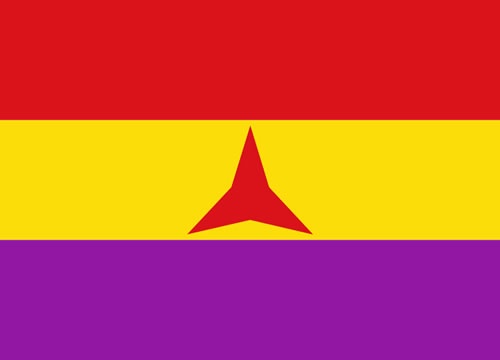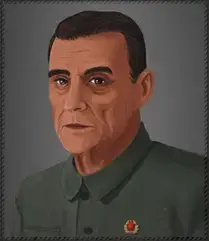Just sharing something silly that I decided to put together. Try to see how many of them you can recognize. Optional video essay background music to go along the post.
Tier 1: The big three. On top of the iceberg due to the enormous impact that they have had in the world’s history and popular culture, being known by even the most politically illiterate. It is very likely you have been told more than once to move here by angry people during political discussions.
Tier 2: Smaller socialist states that stand out more than the rest in their respective regions. Still well known and recognized, but most people have a weaker grasp on them than on the ones listed on the tier above.
Tier 3: More unlikely to pop up in debates about communism, this likelihood increases drastically if the person you are talking with had a grandmother whose castle, servants and favourite pony were taken away by one of these states.
Tier 4: This tier marks a barrier: an average Jane and Joe is most likely not able to recognize these. However, they do not suppose a very deep level of knowledge for a ML, who should already know about their existence and point one or two facts about them at the very least.
Tier 5: Many people are unable to even point on a map where these countries are located, and much less to even know that they were once socialist states. If you know in depth about them, it is very likely that you put a desproportionately large focus on anti-colonialism and anti-imperialism in your theory journey. It is also equally as likely that you haven’t seen the sun in years.
Tier 6: The bottom of the iceberg. These states are almost never mentioned even by the people who are well read on the states on the tier above, despite the very unique and interesting challenges that they had to face as socialist projects. Venturing into these shows a willingness to search for knowledge further away than anything that you will ever need in practice.
Tier 7: The dark depths of socialist history. Some are states that lasted for several years flying under the radar of even the most dedicated MLs, but most of these are ephemeral projects, having lasted as much as the elements at the bottom of the periodic table, or what is the same, about two or three times longer than the average anarchist project. If you know about these, you either live in the place where they existed or you most likely learnt about them not in the pursue of anything practical, but searching for knowledge purely for the sake of it.
Tier 8: Have you ever had a dream that that you um you had you’d you would you could you’d do you wi you wants you you could do so you you’d do you could you you want you want him to do you so much you could do anything?
sad that mongolia is almost forgotten, given the importance they had in the formation of soviet union
It’s in such a key region, right between Russia and China. I had a friend from there, unfortunately they became cringe and joined up with US Army and they are a huge boot now lol. Last time I made casual conversation to see how they liked the military and they literally said “if I told you, I would have to kill you” like stfu bro your ass is working on a Humvee in Phoenix😂
mongolia is a good stalking horse for tibet without the impression of ‘foreign domination’, talking about the monasteries being fucked up an the mongolian people liquidating them… then you drop that that’s the same thing they had in tibet

Sükhbaatar my beloved
can you name the bottom 3 tiers flags for the uniniated
Watch out spoilerinos!!1!
Tier 6:
spoiler
From left to right: Mongolian People’s Republic, Tuvan People’s Republic, Xinjiang Clique.
Tier 7:
spoiler
From top to bottom, left to right: Cape Verde, Guinea-Bissau, Second Republic of Seychelles, Socialist Republic of the Union of Burma, Inner Mongolian People’s Republic, People’s Republic of Zanzibar, Persian Socialist Soviet Republic, Chinese Soviet Republic, People’s Republic of Korea, Azerbaijan People’s Government, Republic of Mahabad, Various European/Asian interwar Soviets, Provisional Democratic Government/“Mountain Government”.
Tier 8:
spoiler
Wa State.
Tannu what?
Shoo, shoo. Go away, HOI4 player.
Hahaha. I knew all of Tier 6 because of HOI4.
You must now print a picture of Sukhbaatar and another of Choibalsan, hang them on the wall of your bedroom and beg them every night to forgive you for your sins.
I can’t hear you over the sound of the naval invasion alert.
What’s WA State?
A strange breakaway state in Myanmar that is essentially the remnants of the Burmese Communist Party and various rouge military units that escaped into the jungle after the civil war. They aren’t recognized, and hold little to no meaningful power; just a few villages in the jungle.
They don’t do anything much, so the government just leaves them alone.
They are the equivalent of de facto Central American “cartel states” like Sinaloa.
I will admit I’ve heard of zero of these. Interesting
I think the PRK should be pretty known for anyone who has done a surface-level study of modern Korean history, such as reading Patriots, Traitors, and Empires.
Probably, although reading books specifically on modern Korean history isn’t that much of a popular activity. I won’t lie, it should have been one tier up, but the need to have all ephemeral countries shoved together into one single tier was stronger than I was.
Burmese Way of ‘Socialism’

You seem sad. Would a 90 kyats banknote cheer you up?
What was wrong with it specifically? I just did a surface level reading
Khmer Rouge/Pol Pot Cambodia…… Socialist state….
Something doesn’t track here.
Reading too much theory like me leaves you with the sight of a mole for things that are far away, but also with the eyes of a falcon for very tiny and small things that are close. That is the flag of the People’s Republic of Kampuchea, not to be confused with the Khmer Rouge’s Democratic Kampuchea. The flags are slightly different.
Ahhh, its the Vietnamese backed state, that makes a lot more sense! I forgot that they had a very similar flag, and from a distance all I saw was “Red flag, yellow peaked building”, which threw me for a loop.
Thanks for the clarification!
No worries! To be fair I did considering putting in Democratic Kampuchea, as it wouldn’t be the only dumpster fire under the name of socialism that is on that list. However I decided not to, on the basis of not wanting to repeat several iterations of socialist (or “socialist”) states encompassing the same geographical area. Otherwise, there would be many, many more chinese communist flags from the Civil War era in there and I didn’t want to be redundant.
deleted by creator
Very good list, but there are some mistakes in this:
- The Xinjiang Warlord, which was not a socialist regime, but only implemented some socialist policies.Sheng Shicai, the leader of the Xinjiang Warlords, had adopted a policy of alliance with the Communists in the early period, but in 1942 he defected from the revolution to the Kuomintang and killed a large number of Communists, including Mao Zedong’s brother Mao Zemin. For more information, see Sheng Shicai’s Baidu encyclopaedia entry.https://baike.baidu.com/item/盛世才?timestamp=1704252459758&fromModule=search_box(Chinese)
- The drug and telecommunication fraud problems in Wa have hurt the general public in China and have even become the backbone of the local economy in Wa.https://baike.baidu.com/item/佤邦?timestamp=1704253230510&fromModule=search_box(Chinese)
no spanish republic

no mexican liberal party

no spanish republic
Funny you say that, because I had the same complaint from a person who made the role of test audience. The 2SR is the best period of Spanish history, but it was no socialist state and CEDA’s rule from 1934 to 36 is proof of that.
no mexican liberal party
That learns more towards the side of anarcho-communism, and I decided to not include those (even if they also have their little hidden projects that have been forgotten by history).
nah we talking about the Caballero government not the dang CEDA! its “underground” in the sense reds were running an ostensibly bourgois republic with a liberal president for 2 years or so
mexican liberal party is great because it’s called liberal, lol the magónistas are a footnote at best in the grand scheme of the revolution
nah we talking about the Caballero government not the dang CEDA! its “underground” in the sense reds were running an ostensibly bourgois republic with a liberal president for 2 years or so
You see, “bourgeois state run secretly by reds” would make a lot of countries get into the list and it was somewhere that I had to put the line to decide which states are in and which ones are out. At first I even considered putting inside every country that ever made a reference to socialism in their constitution, but that would put Portugal in, despite having been nowhere close to work socialist state the likes of the USSR. I even had to discard countries that ran on arab socialism like Lybia.
fair
I feel like North Korea should be in T1 and Cuba T2.
All the libs in the west love to point at scary North Korea but seem to almost forget Cuba is socialist. Heck there are even some libs in the US who are like “why are we still blockading them?” which says a lot.
Really didn’t expect to see the (old) Greek flag, but there it is, included towards the end of tier 7. So here’s a little bit of history that nobody has asked of, yet I hope will prove to be an interesting reading. It is about the two “Mountain Governments” of Greece, both formed by the Communist Party -during, and in the aftermath of- WWII.
The first one was formed during the war, when the communists led the struggle against the Nazi occupators. Communist led ELAS and EAM guerillas, as well as right-wing EDES, had organized themselves and waged partisan war against the Nazi with remarkable success. They managed to establish the first free government of liberated Greece in 1944 (https://en.wikipedia.org/wiki/Political_Committee_of_National_Liberation/) in the areas that they had managed to free, in spite of both Athens’ Nazi-installed collaborationist “government” and the old bourgeoisie government that had fled to Cairo when the war broke out. The government-in-exile, led by king George II, was pretty powerless in its current situation, but for Western countries it remained the “official” government which represented Greece. Meanwhile, the “Mountain Government”, largely (if not mostly) communist-led, planned some important educational reforms in the liberated areas, and even held its own elections. The remarkable thing about them is that, for the first time in Greek history, women were allowed to vote.
When the Nazi left Greece, the bourgeoisie government felt safe enough to return from abroads. The Provisional Democratic Government was dissolved several months after it had been formed after a government of national unity was established in the now fully liberated Greece. Communists argued that the newly formed government was problematic because it included former collaborators of the Nazi and it served the interests England, who had found the chance to meddle extensively with Greek affairs. Guerilla forces were forcedly disbanded in favour of a national army, which the government tried to “cleanse” from anybody they considered to lean even slightly towards the Left. Prosecution of former members of EAM and ELAS began. A peaceful demonstration of EAM was violently crushed by the English armed forces and local right-wing armed paramilitia. White terror began, forcing a lot of people into hiding. This is how the Greek civil war broke between the anti-communist bourgeois government, supported by right-wing militia and England, and left-leaning factions of EAM-ELAS.
In these conditions the Communist Party organised partisans into a small army (Democratic Army of Greece), seized some mountainous areas and proclaimed a new government in 1947 (https://en.m.wikipedia.org/wiki/Provisional_Democratic_Government). It didn’t last long, either. The Athens government won de-facto in 1948, and the second “Mountain Government” was dissolved in exile, in 1950.
Neither time did communists really have a chance to prove themselves in long-term government, as both of those goverments were provisional and existed in the midst of a war.
Wow, that turned out longer than I expected it to be. Still, I hope it was not too boring. The truth is, there is way too much history behind these events, entire books are dedicated to the events of those years. I just wanted to share the basic facts about it in the hope that somebody finds it useful/interesting.
Poland isnt tier 2 for shit. aint nobody knowing them.
DPRK didnt have as much impact but is vastly more well known than any others. Also, Nukes.
It’s a bit biased according to personal criteria, tbh. Also, the tierlist can be interpreted in several ways, like “knowing that these exist” but also as “knowing how do/did they work, their history and so on”. According to how you interpret it, a few flags may move one tier up, one tier down.
I think you forgot Laos
It’s the 1st flag by the left in the 4th tierIf a country by that name existed then people would talk about it. And no one ever talks about Laos.Thank you I just missed it















